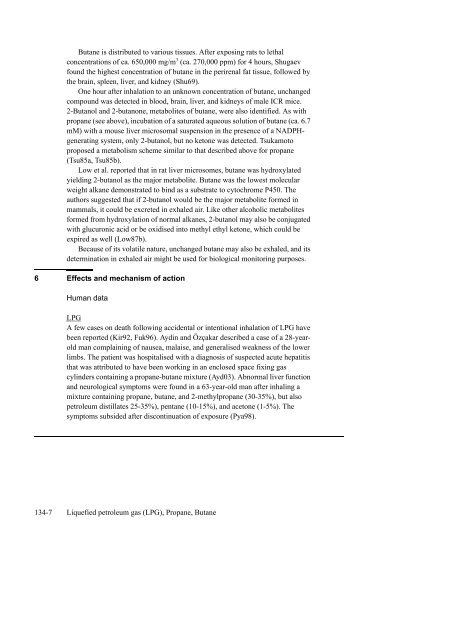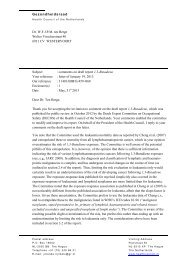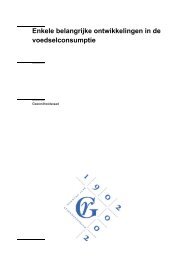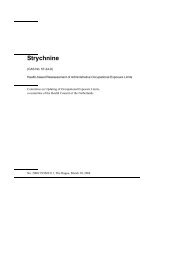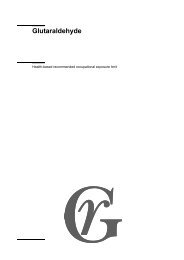Liquefied petroleum gas (LPG) - Gezondheidsraad
Liquefied petroleum gas (LPG) - Gezondheidsraad
Liquefied petroleum gas (LPG) - Gezondheidsraad
Create successful ePaper yourself
Turn your PDF publications into a flip-book with our unique Google optimized e-Paper software.
Butane is distributed to various tissues. After exposing rats to lethal<br />
concentrations of ca. 650,000 mg/m 3 (ca. 270,000 ppm) for 4 hours, Shugaev<br />
found the highest concentration of butane in the perirenal fat tissue, followed by<br />
the brain, spleen, liver, and kidney (Shu69).<br />
One hour after inhalation to an unknown concentration of butane, unchanged<br />
compound was detected in blood, brain, liver, and kidneys of male ICR mice.<br />
2-Butanol and 2-butanone, metabolites of butane, were also identified. As with<br />
propane (see above), incubation of a saturated aqueous solution of butane (ca. 6.7<br />
mM) with a mouse liver microsomal suspension in the presence of a NADPHgenerating<br />
system, only 2-butanol, but no ketone was detected. Tsukamoto<br />
proposed a metabolism scheme similar to that described above for propane<br />
(Tsu85a, Tsu85b).<br />
Low et al. reported that in rat liver microsomes, butane was hydroxylated<br />
yielding 2-butanol as the major metabolite. Butane was the lowest molecular<br />
weight alkane demonstrated to bind as a substrate to cytochrome P450. The<br />
authors suggested that if 2-butanol would be the major metabolite formed in<br />
mammals, it could be excreted in exhaled air. Like other alcoholic metabolites<br />
formed from hydroxylation of normal alkanes, 2-butanol may also be conjugated<br />
with glucuronic acid or be oxidised into methyl ethyl ketone, which could be<br />
expired as well (Low87b).<br />
Because of its volatile nature, unchanged butane may also be exhaled, and its<br />
determination in exhaled air might be used for biological monitoring purposes.<br />
6 Effects and mechanism of action<br />
Human data<br />
<strong>LPG</strong><br />
A few cases on death following accidental or intentional inhalation of <strong>LPG</strong> have<br />
been reported (Kir92, Fuk96). Aydin and Özçakar described a case of a 28-yearold<br />
man complaining of nausea, malaise, and generalised weakness of the lower<br />
limbs. The patient was hospitalised with a diagnosis of suspected acute hepatitis<br />
that was attributed to have been working in an enclosed space fixing <strong>gas</strong><br />
cylinders containing a propane-butane mixture (Ayd03). Abnormal liver function<br />
and neurological symptoms were found in a 63-year-old man after inhaling a<br />
mixture containing propane, butane, and 2-methylpropane (30-35%), but also<br />
<strong>petroleum</strong> distillates 25-35%), pentane (10-15%), and acetone (1-5%). The<br />
symptoms subsided after discontinuation of exposure (Pya98).<br />
134-7 <strong>Liquefied</strong> <strong>petroleum</strong> <strong>gas</strong> (<strong>LPG</strong>), Propane, Butane


